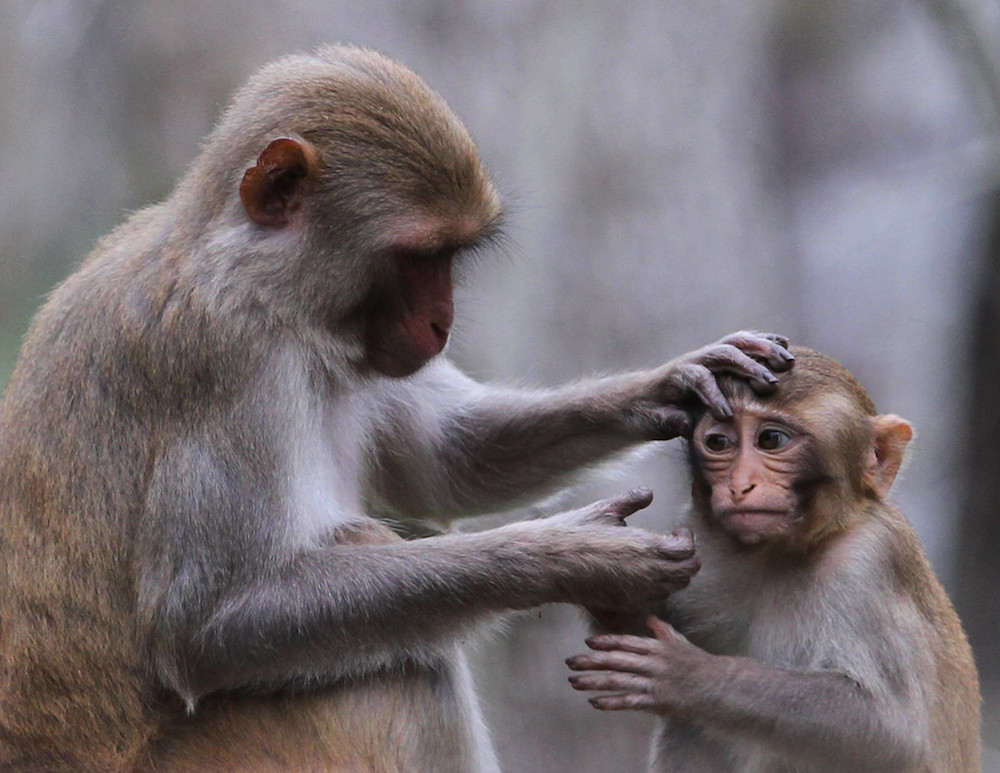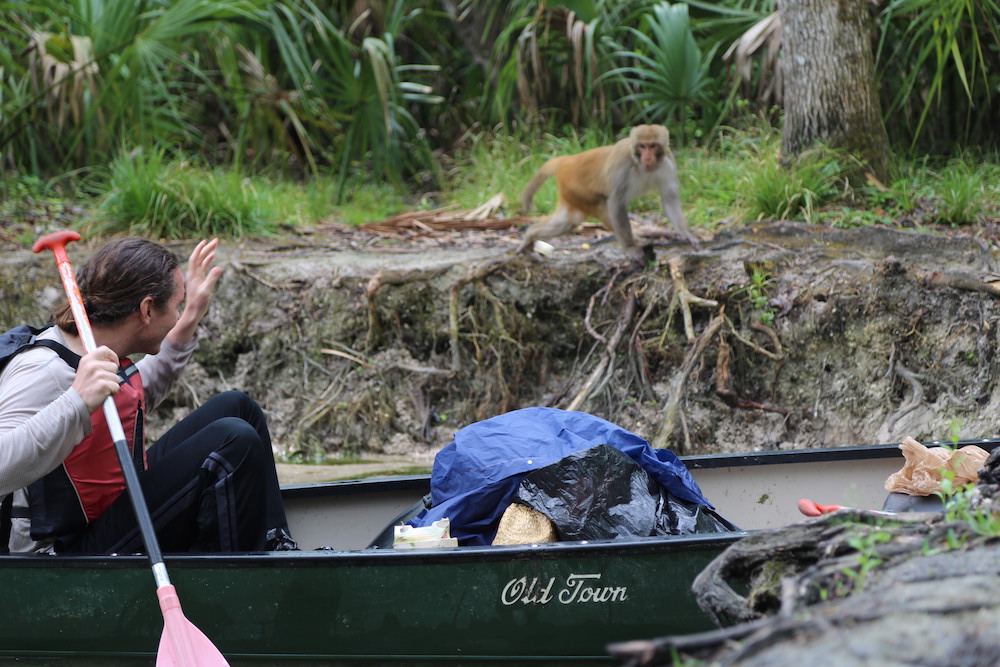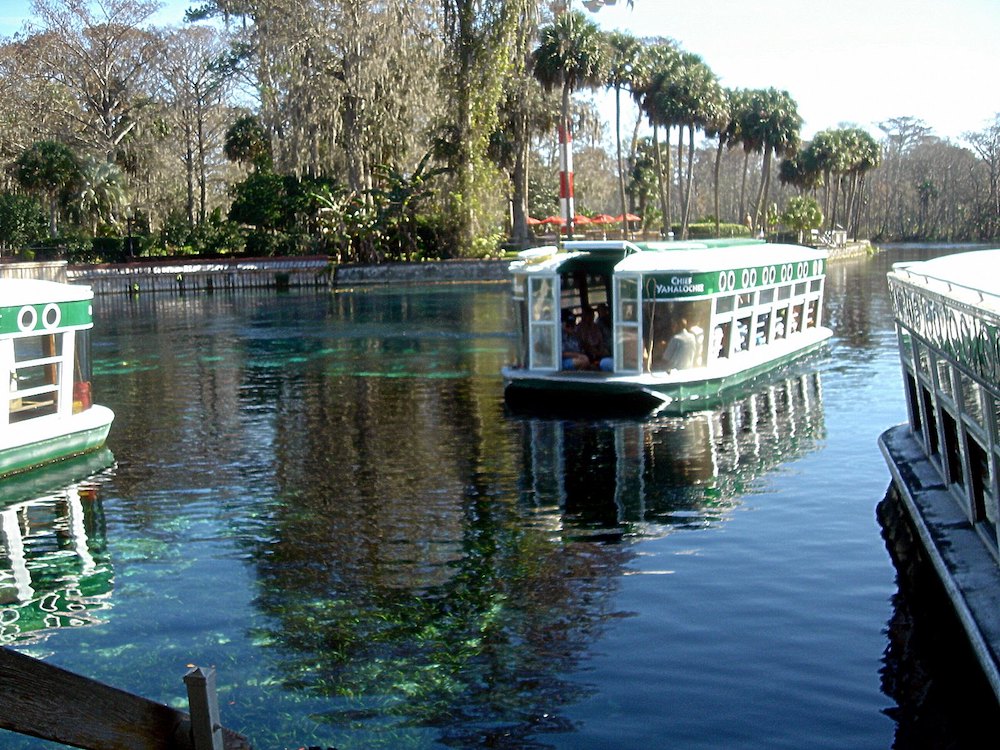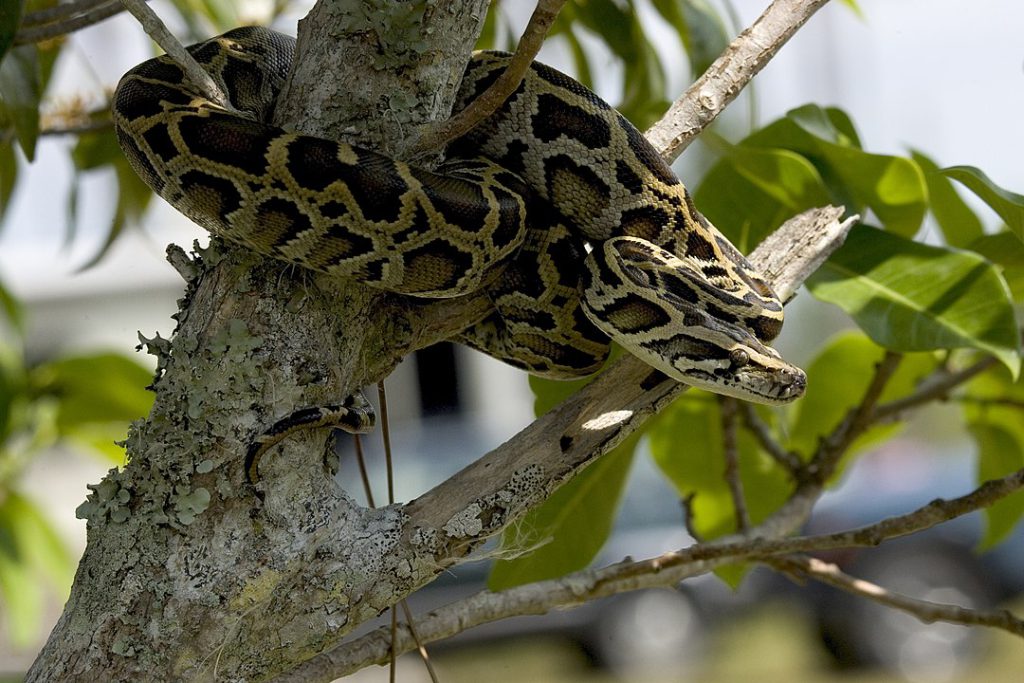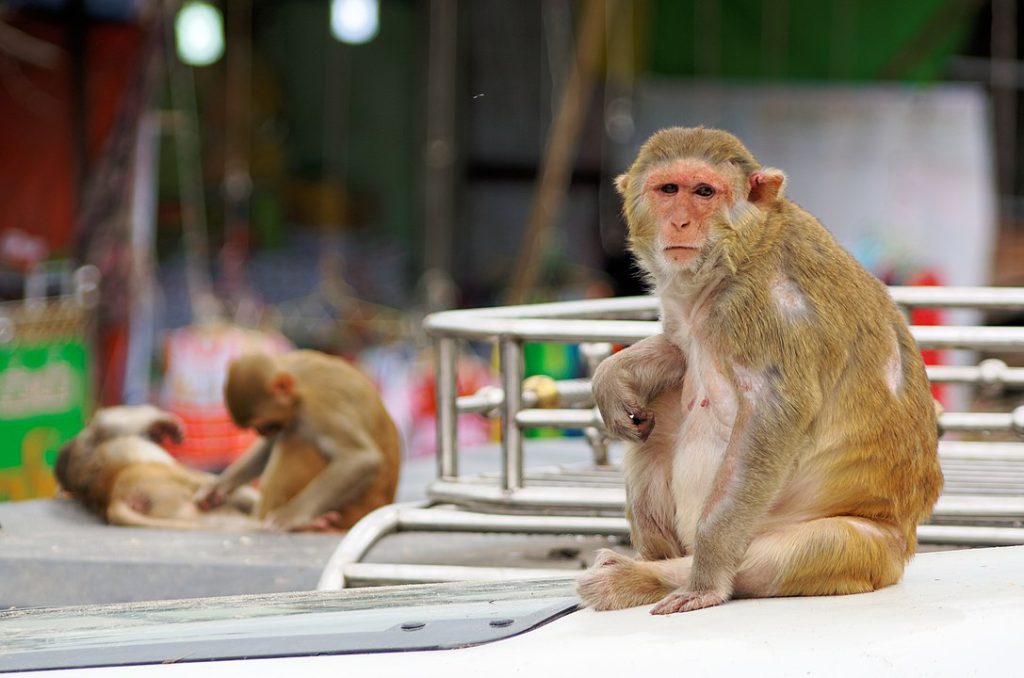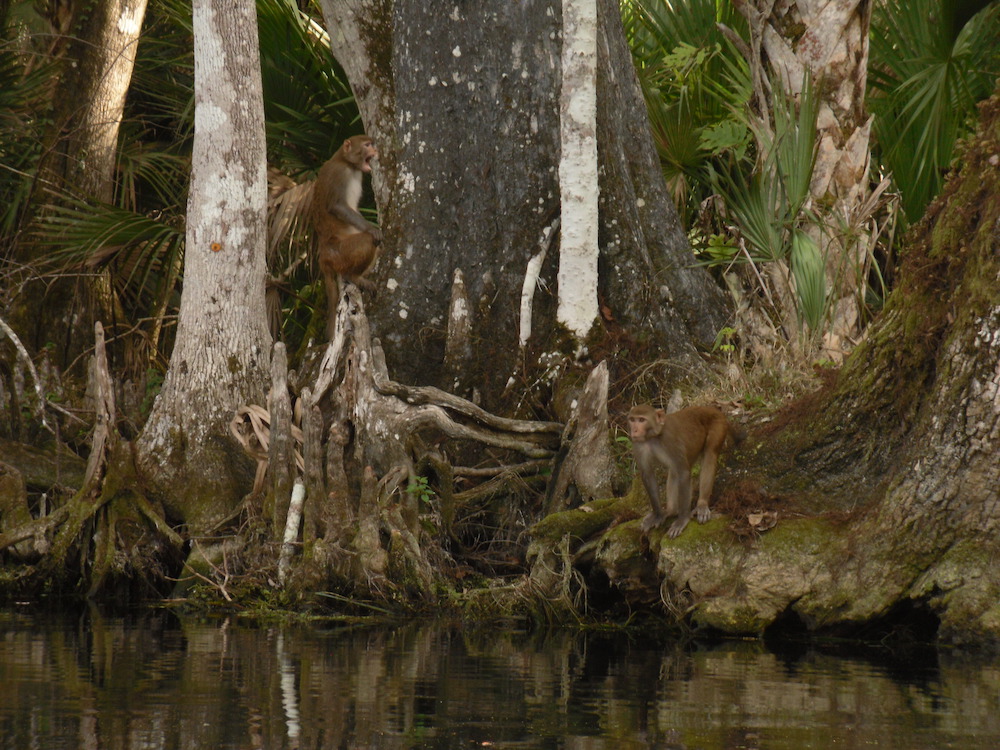Can an “Invasive Species” Earn the Right to Stay?
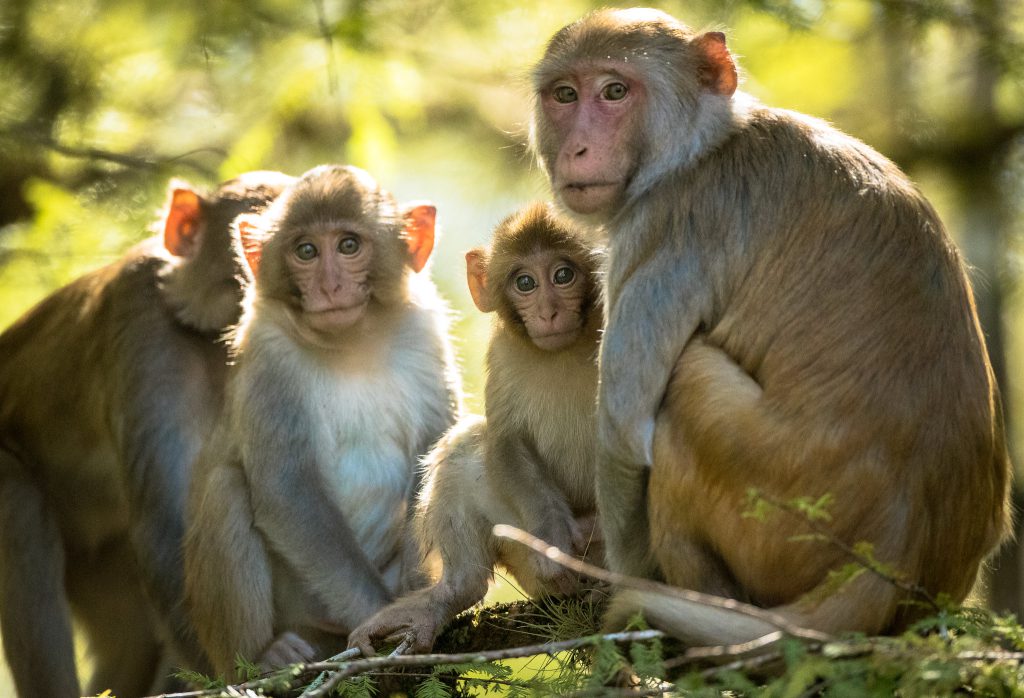
Steve Johnson never thought he’d have to worry about death threats, not in his line of work. Johnson is a wildlife biologist, a field in which controversies typically take the form of pointed words spoken at conferences or written to the editors of academic journals.
But in 2015, his name blared from the website of an animal rights organization known for advocating violent acts against scientists. “This was a scary group,” recalls Johnson, an associate professor at the University of Florida, Gainesville. “Basically, you could call them terrorists.”
The unwelcome attention came while Johnson’s team was studying a group of antic, brownish-gray rhesus macaques, primates from Asia that have been living for years near Silver Springs in central Florida. To better understand the animals’ impact, the scientists were trying to gather data on where in the forest they spent most of their time.
They had obtained the necessary permits, trapped a female, and equipped her with a GPS radio collar. But the collar chafed and boaters noticed the monkey’s neck wound. That’s when the underground network of animal welfare activists sprang into action.
Studying the macaques had never been easy. Johnson and his team wore protective gear and followed specific protocols to avoid contracting a dangerous strain of herpes from the monkeys. But being targeted by humans was, to Johnson, a wholly unacceptable risk.
He and his team found a way to complete the study without touching any more monkeys, then abandoned their macaque research program. “We felt our well-being, our livelihoods, were threatened,” he recalls.
Johnson was unprepared to find himself the focus of a bitter clash that was grounded as much in emotion as in facts. By contrast, cultural anthropologist Eben Kirksey traveled to Florida to study the macaques precisely because he finds such messiness fascinating.
For Kirksey, the presence of animal rights extremists was not a deterrent; rather, it suggested he was onto something important. He is interested in the diverse emotions and priorities that emerge when humans become “entangled” with other species, so the passionate divisions unfolding around Florida’s monkeys made for a promising investigation.
Flexible and hardy, rhesus macaques are the most widely distributed primate on the planet besides humans. In central Florida, spotting them has been a treat for generations of vacationers. The macaques are intelligent and playful. Females care for their young so tenderly that, as one observer put it, “it’s almost a lesson to us” in how to parent.
Yet some officials believe Florida’s macaques pose a threat to human health and native wildlife. Meanwhile, in February, wild macaque sightings were reported for the first time 100 miles north of the Silver River, in Jacksonville. Experts say it will be increasingly difficult to manage the macaque population if it continues to spread into populated areas.
Florida overflows with nonnative species: feral hogs, lionfish, fire ants, and hundreds of others. This menagerie fascinates Kirksey. He is drawn to wild places where human activities have created new combinations of plants and animals.
Species introduced to new habitats are typically viewed with the suspicion that they thrive at the expense of native flora and fauna. But Kirksey, a member of the Institute for Advanced Study in Princeton, New Jersey, and an associate professor at Deakin University in Melbourne, Australia, wants to get beyond such automatic assessments. Whereas biologists traditionally tend to prioritize the welfare of native species, Kirksey takes a more expansive approach. He sees value in the lives of displaced animals such as the Silver River macaques. And he thinks their connections to the people around them matter too.
Silver Springs, source of the serene and almost magically transparent Silver River, was Florida’s original tourist attraction. Vacationers began arriving shortly after the Civil War, and before long, the main attraction became the glass-bottom boat tour. Seated comfortably, visitors could look down for intimate views of abundant native wildlife: alligators, turtles, manatees.
There is haziness about how the macaques arrived, but according to some accounts, in the 1930s, an entrepreneurial boat operator bought a few from a traveling sideshow and let them loose to provide passengers with an additional thrill. Park workers fed the macaques to keep them nearby, and their numbers grew into the hundreds by the 1980s. But due to sterilization efforts and trapping, there were about 100 monkeys living wild on the Silver River when Kirksey began his research in 2011.
Kirksey, then 43, was known for co-writing the seminal paper on an increasingly popular anthropological practice known as “multispecies ethnography.” Multispecies ethnographers emphasize the profound interdependence between humans and other life forms—from the plants and animals we eat to the trillions of gut microbes that maintain our health. “No kind of being exists in isolation,” Kirksey says. “We bring each other into being.”
“No kind of being exists in isolation,” says anthropologist Eben Kirksey. “We bring each other into being.”
The multispecies investigations conducted over the past decade cover an astounding amount of ground. They include Kendra Coulter’s studies of the work animals do—including the “emotional labor” performed by pets—and Piers Locke’s “ethnoelephantological” research, which attributes individuality and meaningful social lives to elephants as well as people.
Kirksey studies what he calls “novel ecological assemblages”—the combinations of life forms that coexist in modern ecosystems. Anthropological perspectives on this subject have changed over time. When anthropologists first considered the issue of plants and animals being introduced to new habitats through global travel and commerce, as happened with Florida’s macaques, they thought scientists were unfairly vilifying these species by using terms like “invasive” or “alien.” They detected parallels to the harsh treatment of human migrants and to xenophobia.
But more recently, many anthropologists have reconsidered. By reflexively advocating for invasive species, they realized, they were essentially giving a pass to corporations to act without concern for environmental impacts. “Out-of-whack ecologies are being proliferated by industrial projects,” says Zachary Caple, a cultural anthropologist and fellow multispecies ethnographer at the University of South Florida. “Exotic species are not inherently bad, but they can become biological pollution in their relation to the ‘mine, blast, dump, crush, extract, exhaust’ of modernity.”
Kirksey charts a middle course. He believes in trying to control nonnative species when they pose an outsized threat. The Burmese python, for example, has decimated opossums, bobcats, and other animals in the Everglades. But he rejects the bias that every plant or animal that is “out of place” is destructive.
“When should we let unruly forms of life run wild, and when should we intervene?” Kirksey wrote in the introduction to his 2015 book Emergent Ecologies. That was the question he was asking when he traveled to Florida to weigh in on the monkey controversy.
Once in Silver Springs, Kirksey interviewed a local historian, a river tour guide, and the Silver Springs State Park manager. But he didn’t limit himself to official voices.
He spent days on the river in a canoe, talking with kayakers seeking tranquility and rowdy motorboaters looking to get their ya-yas out. At the supermarket, he met a man who said he’d shot and stuffed a macaque to keep on his mantelpiece. “I was looking for people who have knowledge that is created as a result of their own life practice,” Kirksey says. “People who had spent a lot of time with the monkeys.”
Thanks to his experience in multispecies ethnography, Kirksey also spent a lot of time observing the rich social lives of the macaques themselves. The animals live in four distinct troops, each with its own social structure.
Kirksey noticed that moments of interaction between monkeys and humans tended to be emotionally charged on both sides. It was as if encountering a creature at once familiar and foreign inspired each primate species to deviate from social norms.
Macaque troops are hierarchical, with an alpha male in the top position, followed by the matriarch. These two animals normally get first dibs on any delicacy, but when boaters threw snacks willy-nilly, the monkeys were freed from these strict conventions. Young monkeys darted after the food, exploiting the chaotic moment to secure a coveted treat. When food landed in the water, Kirksey observed, macaque youngsters dove after it, despite the risk of being nabbed by alligators, a threat they were too inexperienced to appreciate.
Macaques were not the only ones feeling unfettered during these cross-species encounters. People, too, became excited in the presence of the monkeys, shedding their inhibitions.
Some boaters shouted “oo-oo, ah-ah, ee-ee” calls. Others took foolhardy risks and crossed the line of socially acceptable behavior when in the macaques’ territory. For example, a man who went by “John Daniels,” who met Kirksey on the river, veered into offensive humor at times and grabbed a baby alligator by the tail in an impulsive act of machismo.
But Kirksey also witnessed moments of cross-species empathy and understanding. In fact, he found that humans and macaques had learned much about each other from mutual observation.
Macaques were not the only ones feeling unfettered in cross-species encounters. People, too, shed their inhibitions.
Daniels, for example, proved to be a careful student of monkey behavior. He taught Kirksey that macaques differentiate between people in canoes and kayaks (who usually do not bring food) and people on motorboats (who usually do).
Although it’s against the law to feed the monkeys, many people do it anyway. All it took was a crackling sound reminiscent of a snack bag for Daniels to lure them into view.
The most poignant example of empathy came from a local woman who had assisted a trapper in removing macaques and selling them to medical research labs. Nervous about reprisals, she agreed to meet Kirksey late one night at a bar if he did not reveal her name.
The trapper, she told him, used a dart gun and drug-laced candy to sedate the monkeys, then stuffed them into burlap bags. Though at first she asserted that macaques recover quickly after losing a family member, she later acknowledged, almost despite herself, “I don’t think that they ever get over mourning, to tell you the truth.”
She recalled an incident that seemed to haunt her: A baby macaque whimpered and clung to the outside of the trap that held its mother, refusing to leave. Eventually, a hawk carried off the infant and ate it as the rest of the troop voiced their rage.
Much as the trapper’s assistant wanted to distance emotionally from the monkeys, she couldn’t. To Kirksey, moments of connection that transcend species barriers are meaningful. “Anthropomorphism can help us empathize with other forms of life,” he says. “It helps us appreciate the full implications of our actions.”
One might question what a cultural anthropologist like Kirksey brings to a question that is usually understood in strictly biological terms. But there is a long history of anthropologists weighing in on wildlife management issues.
Whereas ecologists may consider nature a thing apart from humanity, anthropologists remind us that the very notion of an ecosystem is a human construct. “Often what the scientists forget is that everything is political,” says Christian Palmer, an environmental anthropologist at the University of Hawaiʻi. “Climate change is a great example. If you look at the science, we need to be doing things radically differently, but we’re not. Why aren’t we? Well, politics, right?”
In 1981, conservation biologists Paul and Anne Ehrlich made the case that an ecosystem is like an intricate piece of machinery, perfectly calibrated by millions of years of evolution. Every species plays a critical role, and losses could be catastrophic. The Ehrlichs used an airplane analogy: If one mechanical fastener, or rivet, pops, the plane may still fly, but lose several and it will crash.
The idea became mainstream: Change is anathema to a healthy ecosystem. But Kirksey doesn’t buy it.
He points out that creatures brought together by even the most damaging human activities can bring about unexpected ecological consequences. Sometimes, wildlife benefits. For instance, he recently explored how an industrial area in Sydney, Australia, tainted by toxic chemicals has become a refuge for endangered frogs. Could the Florida macaques be another potential success story?
The suggestion that the macaques might be harmless is heresy to Steve Johnson, the biologist targeted by animal rights extremists. “The macaques shouldn’t be there. Neither should the feral hogs. Neither should any nonnative plants,” he says. “I do not buy into the philosophy that we should accept things are changing. Granted, I know the world is very dynamic, but someone has got to be an advocate for our native species.”
But as biodiversity loss and the impacts of climate change accelerate, some ecologists are coming to views similar to Kirksey’s. The spread of species around the globe is so extensive that trying to restore some earlier vision of wilderness no longer makes sense, they say. It’s logistically impossible to remove all alien plants and animals from what they call “novel ecosystems.” From a pragmatic standpoint, it makes more sense to focus time and money on eliminating the species that do the most damage.
More radically, these ecologists reject the long-held assumption that nonnative species are inherently problematic. Ecosystems are always in flux, they contend, and there is no magic formula to any specific grouping of organisms.
Introduced species “are sometimes bad, they sometimes don’t do anything much at all, and they are sometimes beneficial,” says Richard Hobbs, an ecologist at the University of Western Australia and a leading novel ecosystems researcher.
In his assessment of the Silver River macaques, Kirksey began by considering the two main drawbacks that state officials periodically raise: the threat of harm to people and native wildlife.
Two years ago, a study by Johnson and his colleagues confirmed that many of the Silver River macaques carry herpes B virus, which can be fatal to humans. Theoretically, macaque bodily fluids could spread the virus to humans.
To date, however, transmission has occurred only in laboratories, never in the wild—not even in the Balinese temples where macaques famously climb on tourists and steal their cameras. In a 1990 internal memo, Florida’s deputy state epidemiologist wrote that people are more at risk from fire ants than from a herpes B infection from a monkey bite or scratch.
In parts of India, rhesus macaques have become pests—stealing food, damaging property, and biting people. In 2007, the deputy mayor of Delhi died after falling from a balcony while fending off a marauding group of macaques.
But Kirksey doesn’t see that happening in Florida, where most people encounter macaques from boats. The water provides a natural protective barrier. If people learn to keep a respectful distance and not feed the macaques (monkeys that expect food can become aggressive), the risks of injury and herpes would be negligible, he says.
Shirley Redmond, an Ocala, Florida, resident who wrote an opinion piece in support of the monkeys in the local newspaper, agrees. State and local officials need to put up more signs, she says, to inform boaters of the dangers of feeding the monkeys. She has not seen any such notices along the 5-mile portion of the Silver River where she frequently kayaks.
Another consideration is the potential damage macaques pose to native wildlife. Johnson’s team conducted research, published in 2016, suggesting that the monkeys might harm the local bird population by snacking on their eggs. But another study, published in the same year by ethnoprimatologists from San Diego State University, found that, other than the occasional grape or jalapeño cracker thrown by boaters, the monkeys’ diet consisted predominantly of 31 plant species, most of which are relatively abundant.
Kirksey’s macaque calculus included not just potential harms but the possibility of benefits, to both people and monkeys. It is here that his anthropological worldview diverges most abruptly from that of a biologist.
From a ragtag band of monkeys left to manage in an unfamiliar place, the macaques have become a flourishing, organized colony with the distinctive social structures of wild macaques. That is no small feat. Bob Gottschalk, an engineer from Iowa who spent years informally studying the macaques after he retired to Florida, argues that after more than 80 years, the monkeys, though not indigenous, have become native.
Then there is the intangible value of cross-species interactions. Kirksey believes that glimpses of macaque society can be instructive, helping people engage with other life forms. That’s Redmond’s experience. “When I look at them, I’m seeing a family,” she says. “I’m seeing the mother, the father, the little babies. … They are just so much fun to watch.”
Ultimately Kirksey determined that, having thrived for nearly a century on the Silver River without causing significant problems, the macaques have earned the right to stay. “I just didn’t find much evidence that there was any kind of problem,” he says. “I didn’t see much of a ‘there’ there in terms of actual harm to people or to endangered plants and animals.”
Florida officials banned monkey trapping in Silver Springs State Park in October 2013 after public outcry over the fact that trappers sold monkeys to research labs for experimentation. The 2018 study confirming the prevalence of herpes B in the macaques, however, prompted the Florida Fish and Wildlife Conservation Commission to vow to remove the animals.
So far the state has not followed through—even as some media outlets stoke panic over the herpes risk along with the new reports that the macaques are expanding their range. Yet Kirksey says it’s both politically and practically impossible to get rid of the macaques. They are so well-loved that the backlash against removing them would be intense. “A lot of Ocala business owners know the monkeys are what bring them tourists every winter,” he says.
Furthermore, the macaques spread into the Ocala National Forest near Silver Springs long ago. Even if state officials tried to trap or kill all the Silver River macaques, some would evade capture by migrating deeper into the forest. The recent Jacksonville sightings suggest that macaques may be in Florida to stay.
If that is the case, then Kirksey’s work may provide a welcome tonic. Gottschalk, who has advised on many macaque research projects, including Kirksey’s, says the anthropologist brought nuance to a situation that too often runs to extremes. The macaques tend to be either adored or maligned; they are seen as cuddly mascots or vampiric plagues.
The truth, Gottschalk says, is somewhere in between. The monkeys are not tremendous threats, nor are they playmates. They are just primates, not too different from us, trying to make a go of it in a changing world.
In this age of environmental anxiety, Kirksey remains an optimist, seeking hopeful signs in disrupted ecosystems. “In contrast to the conservation discourse, which is a return to Eden, this imagined past that probably never existed, it’s looking at: What does it take to get along together?” Kirksey says, “How to live ethically with those who share the world with us right now.”































